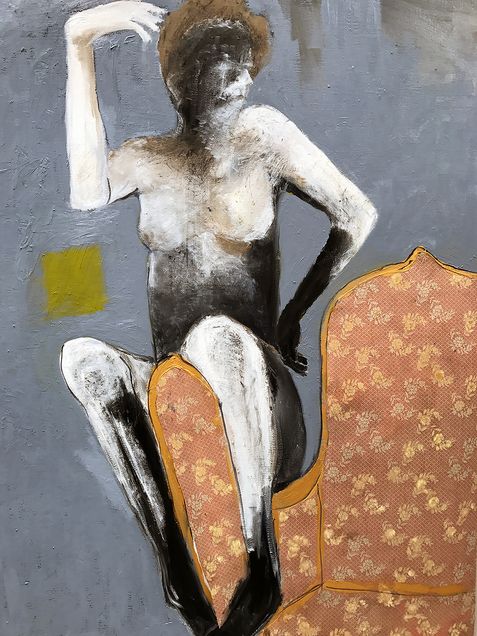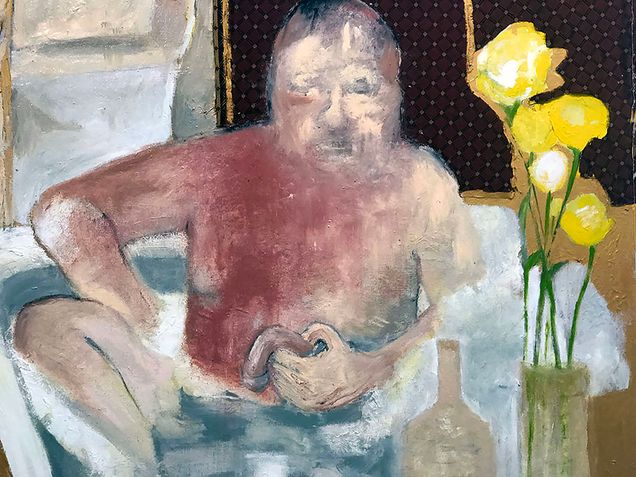Unnatural Return: The Feminist Uncanny
by Elizabeth Rankin
In a recent publication, Alexandra Kokoli explores the concept of the uncanny in feminist thought and in contemporary art practice.1 My doctoral research employs Kokoli’s theories to re-conceptualize representations of women in crime narratives through a close reading of the murder coverage of Linda Agostini in Albury, Australia, 1934. For Kokoli, the uncanny addresses an aggressive defamiliarization of the familiar and is redefined by a range of art practices that resist patriarchal social reproduction. Kokoli delineates the relationship between the abject and the uncanny and argues that each may be present in the actions of the other. According to Kokoli the uncanny profoundly displaces the viewer by recalling the hidden, but may fall short of the utter revulsion felt in confronting the abject.
My painting series, The Pyjama Girl: Imaging the Violence in Narratives of Crime Against Women, investigates how photographs of Linda Agostini’s body that circulated at the time of her murder amplified already existing social codes. These codes objectified the female body within a representational politics of abjection. Abjection when used in this context refers to a projection of taboo and revulsion, one focused on a leaking puerile state of bodily contaminants—the blood of violence and menstruation, urine, decomposition—where the contamination is associated with sexual presence.
Photographs of Agostini’s mutilated body were published locally, nationally, and internationally. This visual display conjured images of her dead body as well as the archival remnants of the crime, in particular the yellow pyjamas she was wearing during the incident. Her identity at this point was unknown, contributing in part to the level of mystification around the case. Her body operated merely as a symbol in the public discourse. The circulation of these symbolic representation operated in conjunction with a performative display of her body in a large container of formalin at the University of Sydney from 1934 to 1944 in the hope that visitors might identify the corpse. Visitors who came to gaze over the preserved corpse were often photographed, furthering this spectatorial archive of her body.
As a child, I was exposed to the archive of this case, including photographs of the victim, facsimiles of her clothes, and death masks of her face, at the Sydney Royal Easter Show’s Police Tent. This evidentiary diorama terrified me. Much of the impetus to develop this project emerges from that tangible fearful memory.

My work considers how the circulation of these images, as well as my own memory of the archive, constructs a visual discourse over the female body as abject within crime. Through the materiality of painting, I unravel the archival power of that childhood moment at the Easter show and the continuing spectacle of abject representations. My process uses strategies of the uncanny to invert the semiotic codes that underwrite the visual order, particularly those embedded in the initial crime photographs and early carnival representations. Using lurid complementary colors, I deconstruct the male body into a visceral state of castration. The violence of this palette allows me to enact an aggressive gaze over the patriarchal lens of what I term “archival power”, the way that artifacts and archives inform societal values and shape collective thought.

Based on a 1944 newspaper image, my painting Anthony and the Dicks (2019) depicts Linda’s husband standing with detectives after he was arrested for her murder. He is wearing Linda’s pajamas like a gruesome skin. He and the detectives are painted with ambiguous genitalia in a symbolic act that undermines the gaze of masculine police surveillance. This image also underscores the relation between the arrestor and the arrested. Both represent the patriarchal formula that continues to define and confine the female victim as an abject sexual object. In Underpants (2019), I reverse the codes of control, embedded in the representational archive, by transforming the male body into an abject, leaking body. Here on display, his body leaks the semiotic codes that define him. The man’s presence remains menacing in his abject state of decay, though stripped of power. This confusion re-orders the symbolic codes that have defined the archival position of the female victim in Western media.

The Pyjama Girl works were shown at Articulate Project Space, Sydney (2020) and MAMA Regional Gallery, Albury (2019).
____________________
Elizabeth Rankin
Elizabeth Rankin is an Australian artist born in the Blue Mountains west of Sydney. She is interested in drawing both still and moving and in the importance of visual narrative in the genre of noir. She studies at the National Art School in Sydney where she completed her MFA in 2017.
____________________
Footnotes
1. See Alexandra Kokoli, The Feminist Uncanny in Theory and Art Practice (London and New York: Bloomsbury Academic, 2016).



